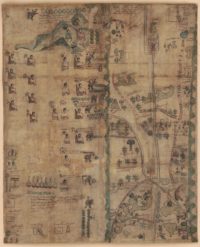 The Library of Congress has acquired an extremely rare manuscript map created by the Nahuatl people of Mexico in 1593. The Codex Quetzalecatzin, also known as the Mapa de Ecatepec-Huitziltepec, is one of very few manuscripts by indigenous Mesoamericans survive unburned, largely because it wasn’t part of the immense literary patrimony of pre-Hispanic cultures that was considered “demonic” because of its hieroglyphics, but rather the product of the Relaciones Geográficas, an extensive mapping project of colonial Spanish America ordered by King Philip II the late 16th century. Surveys sent to colonial authorities in every territory had to be filled in with a range of demographic, geographic, topographic and cartographic information, complete with an accurate and to-scale map of the area. The maps and much of the information on them were made by indigenous people based on local knowledge.
The Library of Congress has acquired an extremely rare manuscript map created by the Nahuatl people of Mexico in 1593. The Codex Quetzalecatzin, also known as the Mapa de Ecatepec-Huitziltepec, is one of very few manuscripts by indigenous Mesoamericans survive unburned, largely because it wasn’t part of the immense literary patrimony of pre-Hispanic cultures that was considered “demonic” because of its hieroglyphics, but rather the product of the Relaciones Geográficas, an extensive mapping project of colonial Spanish America ordered by King Philip II the late 16th century. Surveys sent to colonial authorities in every territory had to be filled in with a range of demographic, geographic, topographic and cartographic information, complete with an accurate and to-scale map of the area. The maps and much of the information on them were made by indigenous people based on local knowledge.
The codex maps southern Puebla from Ecatepec, today a suburb of Mexico City to the church of Santa Cruz Huitziltepec and across the provincial border into northern Oaxaca. It’s drawn in iron gall ink and painted in watercolors on paper. It is rich with hieroglyphics, colorful and compelling drawings and text labelling people and locations in Spanish and in romanized Nahuatl. While we don’t know the name of the artist/s and writers who made the Codex Quetzalecatzin, it does include unique geneaological information about an important local family — several generations of the Nahuatl “de Leon” family from 1480 through 1593 — and the interweaving of indigenous and Spanish cultures in the century after Christopher Columbus.
[T]he Librarian stated: “The acquisition of the map, because of its relevance to the early history of the European contact with the indigenous people of America, makes an important addition to the early American treasures at the Library of Congress, including the Oztoticpac Lands Map and the Huexotzinco Codex. It’s a rare document of world history and American history in general.” […]
As with many Nahua, indigenous group, manuscript maps of the period, the Codex Quetzalecatzin depicts the local community at an important point in its history and the iconography that makes up the map reflects some Spanish influence.
“The codex shows graphically the kinds of cultural interactions taking place at an important moment in American history,” said John Hessler, curator of the Jay I. Kislak Collection for the archaeology of the early Americas of the Library of Congress. “In a sense, we see the birth of what would be the start of what we would come to know as the Americas.”
Hessler added: “The codex relates to the extent of land ownership and properties of the family line known as “de Leon,” most of the members of which are portrayed on the manuscript. With Aztec stylized graphics, the map illustrates the family’s genealogy and its descent from Quetzalecatzin, who in 1480 was the major political leader of the region. It also shows churches, some Spanish place names and images suggesting a community adapting to Spanish law and rule.”
In the codex, certain features that point to indigenous authorship include pre-Hispanic stylistics, such as symbols for rivers, roads and pathways, and hieroglyphic writing. The marginal notations with alphabetic writing utilizing the Latin alphabet and the names of some of the indigenous elites, such as “don Alonso” and “don Matheo,” are clues to its colonial era composition. This is evidence that some indigenous people enjoyed the Spanish title “don” and had been baptized with Christian names.
The LoC has digitized the map and uploaded it to its website, which in case you haven’t seen it yet is one of the greatest photographic archives on the Internet and has been for years, long before other institutions got on the bandwagon of making high-resolution images available online to the general public. It’s so great, in fact, that I couldn’t even upload the full image to this article because it’s so gloriously gigantic my server can’t handle it. I mean, of course I uploaded a gigantic version, but it’s less than half the size of the original behemoth. Behold it in all its grandeur here.